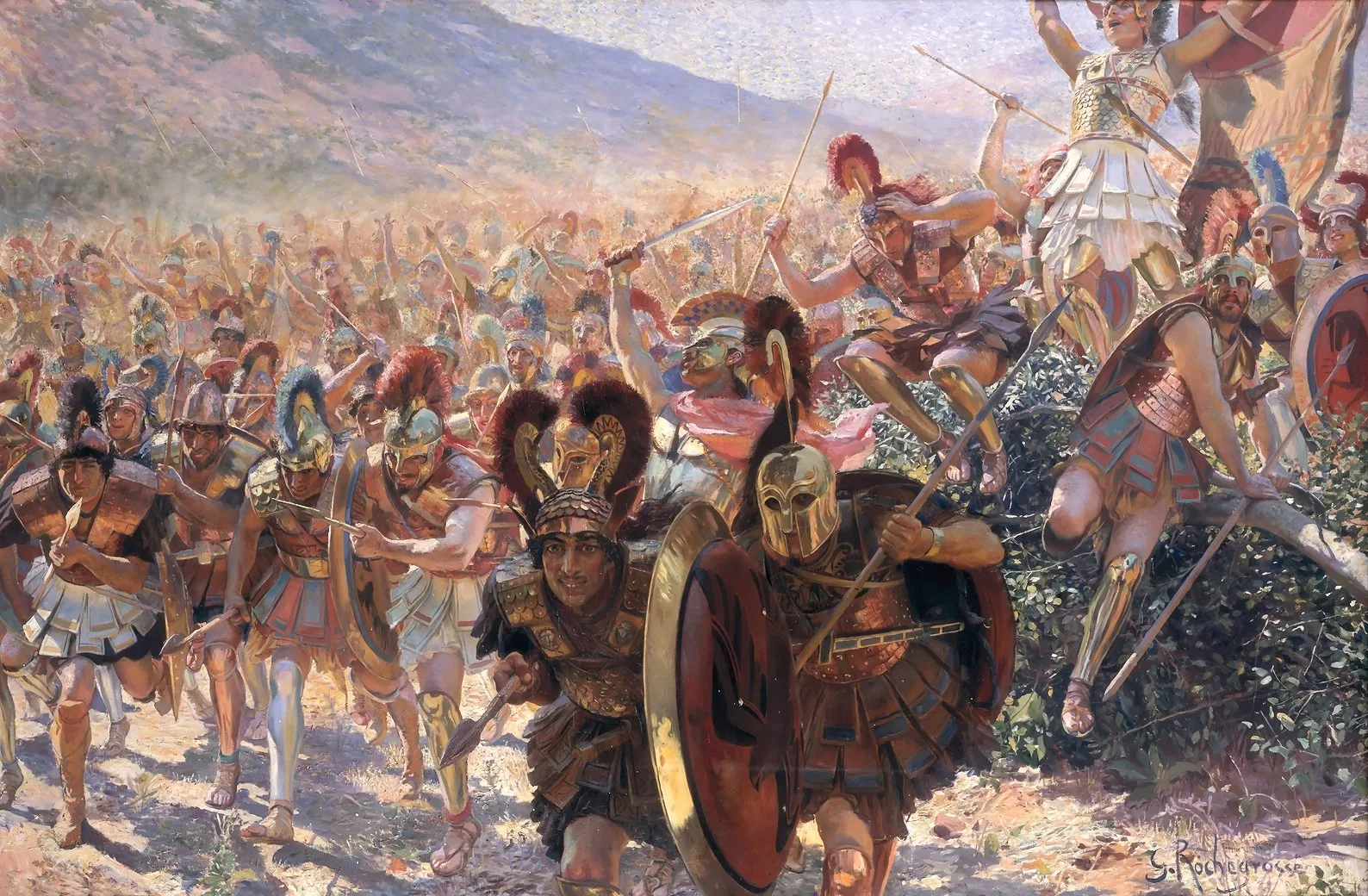
Georges-Antoine Rochegrosse è stato un pittore Orientalista Francese🎨.
Studiò pittura con Alfred Dehodencq e poi entrò nell'Académie Julian, negli atelier di Jules Joseph Lefebvre🎨 e Gustave Boulanger, passando infine all'École nationale supérieure des Beaux-Arts. Partecipò, senza successo, ai Prix de Rome del 1880 e del 1881, ed al Salon del 1882, dove fu premiato. L'anno dopo ottiene una borsa per effettuare un viaggio di studi.
Illustrò anche diverse edizioni letterarie: l' "Odissea", il "Satyricon", l'"Orestea" di Eschilo, "L'uomo che ride" ed "I miserabili" di Victor Hugo, l’"Akëdysseril di Villiers" de l'Isle-Adam, le Princesses di Théodore de Banville, il Salammbô e l’"Hérodias" di Gustave Flaubert ed ancora Charles Baudelaire, Théophile Gautier ed Anatole France.

Scoprì l'Algeria nel 1894 e si stabilì
definitivamente a El-Biar, presso Algeri nel 1900, con la moglie Marie
Leblond, che morì nel 1920 per una malattia contratta nell'ospedale
d'Algeri dove lavorava come infermiera; ogni estate Rochegrosse si
recava a Parigi, poiché faceva parte del collegio giudicante le opere da
esporre al Salon.
Fu ammirato da Théodore de Banville -
suo patrigno, avendo sposato la madre Marie-Elisabeth Bourotte, vedova
Rochegrosse, il 15 febbraio 1875 - il quale gli dedicò una poesia della
sua raccolta Les exilés.
Ottenne ancora, in Francia, diversi successi, come la medaglia
di bronzo all'Esposizione universale del 1889 e quella d'oro
nell'Esposizione del 1899, e nel 1892 fu nominato cavaliere e poi, nel 1910, ufficiale della Légion d'honneur.
Fu professore dell'Accademia di
pittura di Algeri, dove insegnò a una generazione di pittori
orientalisti, come Paul Nicolai, José Ortega, Alexandre Rigotard e
Marcel Rousseay-Virlogeux.

All'inizio della carriera Rochegrosse
fu essenzialmente un pittore di storia, poi, scoperta l'Algeria, un
orientalista e alla fine, dopo la morte della moglie, figlia di Théodore
de Banville, un pittore di soggetti religiosi.
Egli è uno degli ultimi rappresentanti
della pittura accademica, con quadri quali Andromaca, 1883, Musée des
Beaux-Arts di Rouen, La follia di Nabuccodonosor, 1883, Musée des
Beaux-Arts di Lille, Il cavaliere dei fiori (Musée d'Orsay),
titolato dall'autore Il predestinato, rivestito della simbolica armatura
d'argento, va verso l'Idea, incurante dei richiami della
Vita, del 1894, ispirato al mito di Parsifal.
Abitò e lavorò nella casa detta
Chaptal, a Parigi, che ospitò poi il Teatro del Grand Guignol. Tutta la
sua collezione personale, composta di 110 dipinti e 250 disegni e
acquerelli, fu venduta fu ad un'asta il 14 giugno 1993. | © Wikipedia




























Georges Antoine Rochegrosse was a French🎨 historical and decorative painter.
He was born at Versailles and studied in Paris with Jules Joseph Lefebvre🎨 and Gustave Clarence Rodolphe Boulanger.
His themes are generally historical,
and he treated them on a colossal scale and in an emotional naturalistic
style, with a distinct revelling in horrible subjects and details.
He made his Paris Salon début in 1882 with Vitellis traîné dans les rues de Rome par la populace (Vitellius dragged through the streets of Rome by the people) (1882; Sens).
He followed this the year afterwards with Andromaque (1882-83; Musée des Beaux-Arts de Rouen), which won that year's prestigious Prix🎨 du Salon.
There followed La Jacquerie (1885; Untraced), Le mort de Babylone (The fall of Babylon) (1891; Untraced), The death of the Emperor Geta (1899; Musée de Picardie, Amiens), and Barbarian ambassadors at the Court of Justinian (1907; untraced), all of which exemplify his strong and spirited but sensational and often brutal painting.
In quite another style and beautiful in color is his Le Chevalier aux Fleurs (The Knight of Flowers) (1894; Musée d'Orsay, Paris; RF 898).

He was elected an Officer of the Legion of Honor in 1892 and received the medal of honor🎨 in 1906 for The Red Delight. Rochegrosse also illustrated several books.
Some of the drawings for these illustrations are in the Department of Prints and Drawings at the British Museum, London.
He lived his final years in Algeria,
but returned to Paris where he died and is buried in Montparnasse
Cemetery. His wife, Marie Rochegrosse (née Leblond), had died in 1920. | © Wikipedia













